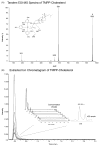Phosphonium labeling for increasing metabolomic coverage of neutral lipids using electrospray ionization mass spectrometry
- PMID: 19449318
- PMCID: PMC3052201
- DOI: 10.1002/rcm.4076
Phosphonium labeling for increasing metabolomic coverage of neutral lipids using electrospray ionization mass spectrometry
Abstract
Mass spectrometry has become an indispensable tool for the global study of metabolites (metabolomics), primarily using electrospray ionization mass spectrometry (ESI-MS). However, many important classes of molecules such as neutral lipids do not ionize well by ESI and go undetected. Chemical derivatization of metabolites can enhance ionization for increased sensitivity and metabolomic coverage. Here we describe the use of tris(2,4,6,-trimethoxyphenyl)phosphonium acetic acid (TMPP-AA) to improve liquid chromatography (LC)/ESI-MS detection of hydroxylated metabolites (i.e. lipids) from serum extracts. Cholesterol which is not normally detected from serum using ESI is observed with attomole sensitivity. This approach was applied to identify four endogenous lipids (hexadecanoyl-sn-glycerol, dihydrotachysterol, octadecanol, and alpha-tocopherol) from human serum. Overall, this approach extends the types of metabolites which can be detected using standard ESI-MS instrumentation and demonstrates the potential for targeted metabolomics analysis.
Figures





Similar articles
-
Use of S-pentafluorophenyl tris(2,4,6-trimethoxyphenyl)phosphonium acetate bromide and (4-hydrazino-4-oxobutyl) [tris(2,4,6-trimethoxyphenyl)phosphonium bromide for the derivatization of alcohols, aldehydes and ketones for detection by liquid chromatography/electrospray mass spectrometry.Rapid Commun Mass Spectrom. 2003;17(5):484-97. doi: 10.1002/rcm.933. Rapid Commun Mass Spectrom. 2003. PMID: 12590398
-
Signal enhancement of glucuronide conjugates in LC-MS/MS by derivatization with the phosphonium propylamine cation tris(trimethoxyphenyl) phosphonium propylamine, for forensic purposes.Drug Test Anal. 2014 May;6(5):500-5. doi: 10.1002/dta.1661. Epub 2014 Apr 21. Drug Test Anal. 2014. PMID: 24753456
-
Improving negative liquid chromatography/electrospray ionization mass spectrometry lipidomic analysis of human plasma using acetic acid as a mobile-phase additive.Rapid Commun Mass Spectrom. 2018 Feb 15;32(3):201-211. doi: 10.1002/rcm.8024. Rapid Commun Mass Spectrom. 2018. PMID: 29105990
-
[Progress in applications of ambient ionization mass spectrometry for lipids identification].Se Pu. 2025 Jan;43(1):22-32. doi: 10.3724/SP.J.1123.2024.06007. Se Pu. 2025. PMID: 39722618 Free PMC article. Review. Chinese.
-
Enhancing detection and characterization of lipids using charge manipulation in electrospray ionization-tandem mass spectrometry.Chem Phys Lipids. 2020 Oct;232:104970. doi: 10.1016/j.chemphyslip.2020.104970. Epub 2020 Sep 3. Chem Phys Lipids. 2020. PMID: 32890498 Free PMC article. Review.
Cited by
-
Chemical Isotope Labeling LC-MS for Metabolomics.Adv Exp Med Biol. 2021;1280:1-18. doi: 10.1007/978-3-030-51652-9_1. Adv Exp Med Biol. 2021. PMID: 33791971
-
Liquid chromatography-high resolution mass spectrometry analysis of fatty acid metabolism.Anal Chem. 2011 Dec 1;83(23):9114-22. doi: 10.1021/ac202220b. Epub 2011 Nov 4. Anal Chem. 2011. PMID: 22004349 Free PMC article.
-
Novel Charge-Switch Derivatization Method Using 3-(Chlorosulfonyl)benzoic Acid for Sensitive RP-UHPLC/MS/MS Analysis of Acylglycerols, Sterols, and Prenols.Anal Chem. 2025 Apr 8;97(13):7157-7164. doi: 10.1021/acs.analchem.4c06496. Epub 2025 Mar 28. Anal Chem. 2025. PMID: 40152551 Free PMC article.
-
Cerebrospinal fluid steroidomics: are bioactive bile acids present in brain?J Biol Chem. 2010 Feb 12;285(7):4666-79. doi: 10.1074/jbc.M109.086678. Epub 2009 Dec 7. J Biol Chem. 2010. PMID: 19996111 Free PMC article.
-
Native chemical ligation approach to sensitively probe tissue acyl-CoA pools.Cell Chem Biol. 2022 Jul 21;29(7):1232-1244.e5. doi: 10.1016/j.chembiol.2022.04.005. Cell Chem Biol. 2022. PMID: 35868236 Free PMC article.
References
-
- Ma S, Chowdhury SK, Alton KB. Curr Drug Metab. 2006;7:503. - PubMed
-
- Fahy E, Subramaniam S, Brown HA, Glass CK, Merrill AH, Jr, Murphy RC, Raetz CRH, Russell DW, Seyama Y, Shaw W, Shimizu T, Spener F, van Meer G, VanNieuwenhze MS, White SH, Witztum JL, Dennis EA. J Lipid Res. 2005;46:839. - PubMed
-
- Gross RW, Jenkins CM, Yang J, Mancuso DJ, Han X. Prostaglandins Other Lipid Mediat. 2005;77:52. - PubMed
-
- Han X, Gross RW. J Lipid Res. 2003;44:1071. - PubMed
-
- Maxfield FR, Mondal M. Biochem Soc Trans. 2006;34:335. - PubMed
Publication types
MeSH terms
Substances
Grants and funding
LinkOut - more resources
Full Text Sources
